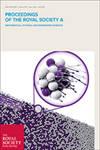在蒸发的半月板和衬底的三交界处附近的热流
Proceedings of the Royal Society of London. Series A. Mathematical and Physical Sciences
Pub Date : 2004-09-08
DOI:10.1098/rspa.2004.1308
引用次数: 4
摘要
题目中的温度满足固体和液体内部的拉普拉斯方程,同时满足牛顿在液气界面处的冷却定律。该边界条件定义了一个长度为L ~ 10nm的界面,在这个边界条件上,界面实际上从接触线上的绝热变为无穷远处的等温。我们给出了一个精确的解,表明当固体占据半空间,液体占据四分之一空间时,这种变化如何影响温度场(因此液固接触角θ=π/2);液固电导率k是任意的。我们用这个解来验证现有的预测分析的极限?→0,θ固定但任意。在距离接触线消失距离的极限r/L→0处,新解约化为已有的局部解。本文章由计算机程序翻译,如有差异,请以英文原文为准。
Heat flow near the triple junction of an evaporating meniscus and a substrate
In the title problem, the temperature satisfies Laplac's equation within the solid and liquid, and Newton's law of cooling at the liquid–vapour phase interface. That boundary condition defines a length L ∼ 10nm on which the interface changes from being, in effect, adiabatic at the contact line to isothermal at infinity. We give an exact solution showing how this change affects the temperature field when the solid occupies a half–space, and the liquid a quarter–space (so the liquid–solid contact angle θ=π/2); the liquid–solid conductivity ratio k is arbitrary. We use this solution to verify the predictions of existing analysis of the limit ? → 0 with θ fixed but arbitrary. In the limit r/L → 0 of vanishing distance from the contact line, the new solution reduces to an existing local solution.
求助全文
通过发布文献求助,成功后即可免费获取论文全文。
去求助
来源期刊
自引率
0.00%
发文量
0
期刊介绍:
Proceedings A publishes articles across the chemical, computational, Earth, engineering, mathematical, and physical sciences. The articles published are high-quality, original, fundamental articles of interest to a wide range of scientists, and often have long citation half-lives. As well as established disciplines, we encourage emerging and interdisciplinary areas.

 求助内容:
求助内容: 应助结果提醒方式:
应助结果提醒方式:


